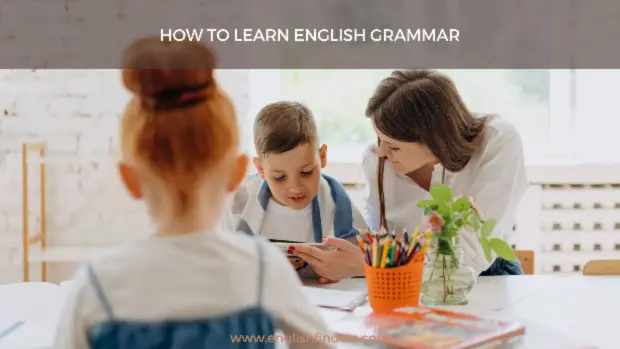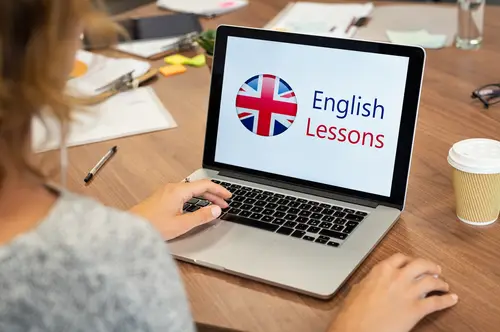Last updated on March 21st, 2023 at 08:08 pm
English grammar is a set of rules that govern how words are used and arranged to form sentences. It’s essential for expressing your thoughts in a clear, concise way and for making sure that your reader understands your message. Learning English grammar can be challenging, but you can progress and become a confident writer with the right guidance.
In this article, I’ll take you through the basics of English grammar, provide tips on how to learn English grammar correctly and recommend resources for further study. So let’s get started!
Introduction to English Grammar
Quick Navigation
As we know, English grammar is the rules governing how words are used and arranged to create meaningful sentences. It comprises various components, such as syntax, morphology, phonology, and semantics, that form words, phrases, and sentences. English grammar is based on the structure of the language, which includes the use of nouns, verbs, adjectives, adverbs, and prepositions.
Learning English grammar can be intimidating, but it’s essential for anyone who wants to communicate effectively in English. With a good understanding of English grammar, you can confidently express your thoughts and ideas in writing and speaking. You’ll also be able to understand better the English language, which will help you pick up new vocabulary more quickly.
Why is Learning English Grammar Important?
Learning English grammar is important because it gives you the tools to communicate accurately and effectively. Expressing your thoughts clearly and concisely ensures your reader understands your message. You may struggle to communicate your ideas effectively without understanding grammar.
In addition to helping you communicate effectively, a good understanding of grammar will help you become a better reader. As you read, you’ll be able to identify and understand the structure of sentences, which can help you to comprehend the text better. This will give you an edge when studying English, as you’ll be able to understand the material better and pick up new vocabulary more quickly.
Basic Rules of English Grammar
Before you begin studying English grammar, it’s important to understand the basics. Here are a few of the most important rules that you should familiarize yourself with:
- Always capitalize the first word of a sentence.
- Use a comma to separate two independent clauses.
- Use a semicolon to separate two related independent clauses.
- Use a colon to introduce a list or explanation.
- Use a question mark (?) at the end of a direct question.
- Use an exclamation mark (!) at the end of an exclamation.
- Use quotation marks (“) to indicate a direct quote.
- Use apostrophes (‘) to indicate possession or a contraction.
- Use the correct verb tense for the context.
- Use the correct pronoun form (I, me, my).
These are just some of the basic English grammar rules you should be aware of. As you continue to study English, you’ll learn more rules and how to apply them.
Common Grammar Mistakes
Being aware of people’s common mistakes is important when learning English grammar. Here are some of the most common grammar mistakes that you should avoid:
- Misusing the present perfect tense (“I have went”).
- Misusing the past tense (“I eat”).
- Misusing the subject-verb agreement (“He don’t know”).
- Misusing the verb tense (“I was went”).
- Misplacing apostrophes (“She’s book”).
- Misusing “less” and “fewer” (“less apples”).
- Misusing “it’s” and “its” (“it’s tail”).
- Misusing “your” and “you’re” (“your welcome”).
- Misusing “there”, “their”, and “they’re” (“they’re house”).
- Misusing “affect” and “effect” (“effect the result”).
By avoiding these common mistakes, you can ensure that your writing is accurate and effective.
Resources for Learning English Grammar
Plenty of options are available if you’re looking for resources to help you learn English grammar. Here are some of the best resources for learning English grammar:
- Textbooks: Textbooks are a great way to learn English grammar basics. They provide comprehensive subject coverage and are often accompanied by exercises to help you practice your skills.
- Online courses: Many online courses help you learn English grammar. These courses provide step-by-step lessons and practice exercises to help you master the material.
- Videos: YouTube and other online sites are great resources for learning English grammar. They provide concise explanations of grammar rules and often include useful examples.
- Apps: There are many apps available that can help you learn English grammar. These apps provide interactive exercises and quizzes to help you practice your skills.
- Websites: There are many websites available that provide helpful resources for learning English grammar. These websites provide tutorials, quizzes, and practice exercises to help you master the material. You can also follow our website to learn English grammar accurately and in easy ways.
How to Learn English Grammar
If you are an English language learner, you know how important it is to learn English grammar rules. English grammar knowledge will help you to communicate more effectively and accurately with other English speakers. This guide will take a comprehensive look at how to learn English grammar.
1. Learn the 8 Parts of Speech
The first step in learning English grammar is understanding the different speech parts. The eight parts of speech are nouns, pronouns, adjectives, verbs, adverbs, prepositions, conjunctions, and interjections. In a nutshell, let’s see the basic definition of each part of speech.
Nouns are names of people, places, things, ideas, etc. Examples of nouns include apple, table, book, and teacher.
Pronouns are words that take the place of nouns. Examples of pronouns include I, you, he, she, it, they, and we.
Adjectives are words that are used to describe nouns and pronouns. Examples of adjectives include large, small, beautiful, and intelligent.
Verbs are words that describe actions. Examples of verbs include run, jump, eat, and speak.
Adverbs are words used to modify verbs, adjectives, and other adverbs. Examples of adverbs include quickly, slowly, loudly, and gracefully.
Prepositions are words that link nouns and pronouns to other words in a sentence. Examples of prepositions include in, on, under, and over.
Conjunctions are words that join words, phrases, and clauses together. Examples of conjunctions include and, or, but, and so.
Interjections are words that are used to express emotions or excitement. Examples of interjections include wow, ouch, yay, and oh.
These parts of speech are the parts and parcel of English grammar. You must have proper ideas for each part of speech to master English grammar.
2. Learn the Phrases and Clauses
Now that we have discussed the different parts of speech, let’s look at phrases and clauses. A phrase is a group of words that does not contain a subject or a verb. Examples of phrases include “in the park,” “up the hill,” and “under the table.” A clause contains a group of words containing both a subject and a verb. Examples of clauses include “he ran,” “she ate,” and “they jumped.”
Phases are classified into many types. Here we’ll see the three types of phrases: noun phrases, verb phrases, and prepositional phrases. A noun phrase consists of a noun or pronoun and any words that modify it. Examples of noun phrases include “the tall man,” “his book,” and “the red car.” A verb phrase consists of a verb and any words that modify it. Examples of verb phrases include “ran quickly,” “ate slowly,” and “jumped high.” A prepositional phrase consists of a preposition and any words that modify it. Examples of prepositional phrases include “in the park,” “on the hill,” and “under the table.”
There are three clauses: independent, dependent, and coordinate. An independent clause can stand alone as a complete sentence. Examples of independent clauses include “he runs in the street,” “she eats vegetables regularly,” and “they jumped in the pond.” A dependent clause cannot stand alone as a sentence. Examples of dependent clauses include “when he ran,” “if she ate,” and “because they jumped.” A coordinate clause consists of two independent clauses by joining conjunction (and, but, or). Examples of coordinate clauses include “he made me happy, and I felt proud of him” and “she knows the poem, but she doesn’t recite it.”
3. Learn the Different Types of Sentences
Now that we have discussed phrases and clauses, let’s look at different types of sentences. Sentences are classified into many types. Here we’ll discuss the five types of sentences: declarative, interrogative, imperative, optative, and exclamatory.
A declarative sentence makes a statement. Examples of declarative sentences include “he ran,” “she ate,” and “they jumped.”
An interrogative sentence is a question. Examples of interrogative sentences include “did he run?”, “Did she eat?” and “did they jump?”.
An imperative sentence gives a command or makes a request. Examples of imperative sentences include “run fast,” “eat as much as you can,” and “jump in the river.”
An optative sentence expresses any wish or prayer. Examples of optative sentences include “may he run” and “wish him to jump in the river.”
An exclamatory sentence expresses strong emotion. Examples of exclamatory sentences include “what a run!”, “What an eat!” and “what a jump!”.
4. Learn the Punctuation
Punctuation is an important part of English grammar. Punctuation marks are symbols that add clarity and structure to the writing. The most common punctuation marks are the period, comma, question mark, exclamation point, colon, and semicolon.
The period is used to end a declarative sentence. Examples of sentences that end with a period include “he ran” and “she ate.”
The comma is used to separate items in a list. Examples of sentences that use commas include “he ran, she ate, and they jumped” and “apples, oranges, and bananas.”
The question mark is used to end an interrogative sentence. Examples of sentences that end with a question mark include “did he run?” and “did she eat?”.
The exclamation point is used to end an exclamatory sentence. Examples of sentences that end with an exclamation point include “what a run!” and “what an eat!”.
The colon is used to introduce a list. Examples of sentences that use colons include “he ran: quickly, slowly, and gracefully” and “she ate: apples, oranges, and bananas.”
The semicolon is used to separate two independent clauses. Examples of sentences that use semicolons include “he ran; she ate” and “they jumped; we cheered.”
5. Learn the 12 Types of Tenses
Learning English grammar is all about understanding the 12 tenses: Present Simple, Present Continuous, Present Perfect, Present Perfect Continuous, Past Simple, Past Continuous, Past Perfect, Past Perfect Continuous, Future Simple, Future Continuous, Future Perfect, and Future Perfect Continuous. Each of these tenses has its own rules and uses, so it’s important to understand them properly.
The best way to learn the 12 tenses is by memorizing examples. For example, the Present Simple tense expresses regular or repeated actions. An example of this tense is, “I eat breakfast every morning.” Similarly, the Present Continuous tense expresses ongoing and happening actions. An example of this tense is, “I am eating breakfast right now.” We have a separate lesson for 12 types of tenses in English. Please read them out from here.
Once you understand the basics of each tense, you can practice them by reading, writing, and speaking in English. Reading books, articles, and news stories can help you better understand how each tense is used. Writing in English is also a great way to practice the different tenses. Finally, speaking English can help you become more confident using different tenses.
To ensure you understand the 12 tenses, you can also test yourself by writing sentences for each tense. This will help you remember the rules and the examples more easily. You can also create your examples and practice using them in conversations.
6. Watch English Movies with Subtitles
Another great way to learn English grammar is by watching subtitles in English movies. Watching movies with subtitles can help you understand the language better and improve your pronunciation. When you watch movies with subtitles, you can hear the words spoken and read them, making it easier to understand the grammar.
It’s important to watch movies with subtitles in the same language you are learning. For example, you should watch movies with English subtitles if you are learning English. This way, you can get used to the flow of the language and learn the grammar rules more easily.
Additionally, you should also watch movies that you enjoy. This will make it easier and more fun to learn the grammar rules. When you watch movies that you like, you will be more motivated to learn and understand the language better.
Furthermore, you can also learn new vocabulary by watching movies with subtitles. Reading and writing up unknown words will help you remember them better and use them in conversations.
7. Write every day
Writing in English is one of the best ways to learn and practice grammar. Writing in English helps you learn and remember grammar rules more easily. Additionally, it also helps you become more confident in using the language.
When you write in English, you should focus on writing in a specific tense. For example, if you want to practice the Present Simple tense, you should write sentences using that tense. This will help you become more familiar with the tense and its usage.
Additionally, you should also try to write longer sentences in English. Writing longer sentences will help you better understand the grammar structure and increase your confidence in speaking English.
Finally, you should also try to write about topics you are interested in. This will make it easier and more enjoyable to write in English.
8. Listen Carefully
Listening is an important part of learning English grammar. Listening to English conversations lets, you learn how the language is used in everyday life. This will help you better understand the grammar rules and improve your pronunciation.
Listening to English conversations can also help you pick up on new vocabulary. When you hear someone using a new word or phrase, you can try to figure out what it means and then look it up later. This will help you expand your vocabulary and also understand conversations better.
It’s also important to listen carefully to how people pronounce words. This will help you learn how to pronounce words correctly. You can also listen to podcasts and watch English TV shows to learn more about the language.
9. Improve your Vocabulary
Having a good vocabulary is essential to becoming a better English speaker. To improve your vocabulary, you should learn new words and phrases daily. You can learn new words by reading English books, articles, and news stories. You can also look up words in the dictionary and listen to conversations in English.
You should also focus on using the new words you learn in conversations. This will help you remember them better and make it easier to use them in the future. Additionally, you can also practice using the new words in writing. Writing in English will help you become more confident using the words and learn more about the language.
Finally, you can also try playing word games to learn new words. This can be fun and also help you remember the words better.
10. English Grammar Exercises
Now that we have discussed the different parts of speech, phrases and clauses, types of sentences, punctuation, tenses, etc. Let’s take a look at some English grammar exercises. Here are a few exercises to help you practice your English grammar skills.
- Write a sentence using each of the eight parts of speech.
- Write a sentence using a noun phrase.
- Write a sentence using a verb phrase.
- Write a sentence using a prepositional phrase.
- Write a sentence using a dependent clause.
- Write a sentence using a declarative sentence.
- Write a sentence using an interrogative sentence.
- Write a sentence using an imperative sentence.
- Write a sentence using an exclamatory sentence.
- Write a sentence using a colon.
- Write a sentence using a semicolon.
These exercises will help you practice and master English grammar rules. Once you understand English grammar, you can communicate more effectively and accurately with other English speakers.
Tips For Learning English Grammar
Learning English grammar can be challenging, but a few tips can help you progress. Here are some tips for learning English grammar:
- Practice: The best way to learn English grammar is to practice it. Make sure to read and write as much as possible, and use the material you read and write to practice grammar.
- Get feedback: Getting feedback from a teacher or tutor can help you identify your weaknesses and improve your skills. Make sure to get regular feedback on your writing and speaking.
- Review: Make sure to review and practice the material you learn. This will help you remember it and master it more quickly.
- Use resources: Take advantage of online and print resources to help you learn English grammar. Books, websites, apps, and videos are available to help you learn.
- Don’t give up: Learning English grammar can be difficult, but don’t give up. Keep practising, and you’ll eventually make progress.
Conclusion
Learning English grammar can be challenging, but with the right guidance and resources, you can make progress and become a confident writer. I’ve taken you through English grammar basics in this article, provided tips for learning it, and recommended resources for further study. I hope this article has been helpful and that you now understand English grammar better. Good luck on your journey to becoming a master of English grammar!

Azizul Hakim is the founder & CEO of englishfinders.com. He is a passionate writer, English instructor, and content creator. He has completed his graduation and post-graduation in English language and literature.




